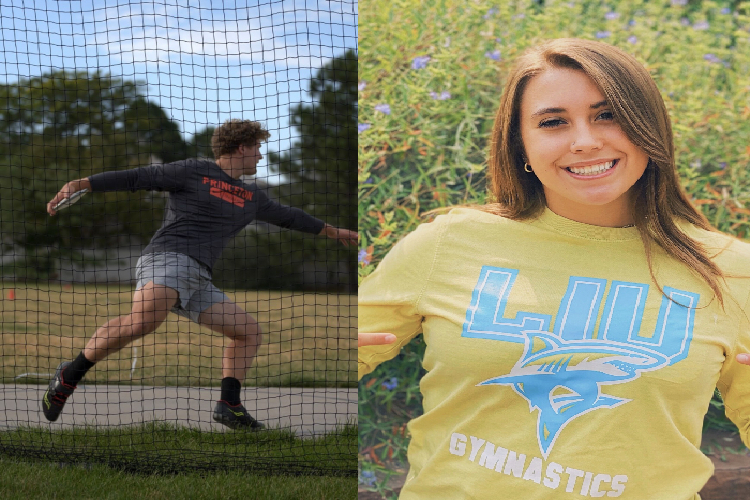
Avery Shunneson committed to Princeton University for Track and Field. Madysen Bradley committed to Long Island University for gymnastics. photos courtesy of Avery Shunneson and Madysen Bradley
During the ongoing COVID-19 pandemic, athletes and universities have had to change their approach to the recruitment process.
Many athletes have felt the impact of the pandemic in many ways. Not only were all practices and competitions canceled, but chances to be recruited by colleges started to dwindle. To make matters even more difficult, the National Collegiate Athletic Association (NCAA) has enacted a “dead period.” This means that college coaches cannot have face-to-face contact with recruits and cannot watch recruits compete or visit high schools. As of September 18th, this dead period will be in effect until the end of this year. Despite these challenges, many athletes have committed to universities during these unpredictable times.
In a normal recruitment process, universities will bring some of their recruits to their school so that they can tour the campus, meet the team, and meet the athletic/academic advisors. This year, however, many of these events have taken place over Zoom. Senior Avery Shunneson, a track and field recruit, stated, “It doesn’t feel real because I have never met any of them, just kind of something that all happened over the phone.” While unconventional, virtual meetings have allowed for the recruitment process to take place.
While the idea of picking a college without visiting can be daunting, athletes have shown great resilience and have committed. Some recruits were able to meet their coaches before the pandemic. Senior Madysen Bradley, a gymnastics recruit, stated, “I didn’t visit the campus, but luckily I have met my coach. He was originally a recruiting scout that attended a few of my meets.” Others were able to see their recruiter’s campus. “I got very lucky and before COVID I went to a football camp at Princeton, so I have sort of [visited the campus]; I didn’t actually get to go on campus, but I have seen their football field,” stated Shunneson. With all the varied experiences, recruiting has proved to be difficult trying to provide the opportunity to meet the coaches and visit the campus for all recruits.
Recruiting has not been the only part of sports that has been affected. Many programs have had to cut athletic programs. The University of Minnesota and the University of Iowa, two major institutions in the college athletics arena, had to cut a total of seven mens’ athletic programs and one womens’ athletic program. In addition to budget cuts, many teams still have not begun to practice or have very strict rules surrounding practices and competitions. In response to the COVID outbreak at the University of Colorado in Boulder, the Denver Department of Public Health and Environment (CDPHE) issued an address for institutes of higher learning. The address states very clearly that masks must be worn at all times. For the University of Denver swim team, this was a possible threat to their ability to practice.
Despite all the unpredictability in sports at the moment, high school and college athletes have shown great resilience. They still continue to work hard every chance they get. With high hopes for high school and college sports, the athletes remain very optimistic about their future in athletics. Bradley stated, “Being able to contribute to a team effort is what I am most excited for when I join the Long Island Gymnastics Team. I can’t wait to be a part of something bigger than myself and be a better athlete not only for me but for my team.”